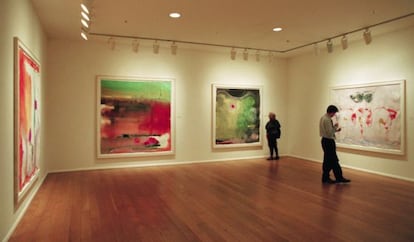The Spanish dealer, the Chinese forger and the $80 million art scam
US authorities uncover massive fraud that fooled top galleries and collectors Works by abstract expressionists such as Jackson Pollock were among those copied


There is no sign of life at the small house in Woodhaven, in New York’s Queens neighborhood, where artist Pei-Shen Qian lived for many years. The place is locked up and the shutters are down. The neighbors say they have no idea where Qian or his wife are.
Qien, who moved to New York from China in 1981 to study painting, is now at the center of a police investigation into an $80 million (€58 million) art forgery case. It is believed that he has returned to China, which has no extradition treaty with the United States.
The story starts back in the 1980s on the streets of Manhattan, where Qian painted and funded his studies by selling his work. One day, a Spaniard, José Carlos Bergantiños Díaz, introduced himself, telling Qian that he was a collector with many contacts in the New York art world.
Bergantiños, along with his wife Glafira Rosales and brother Jesús Ángel, is accused by the FBI of paying Qian to paint copies of works by modern masters such as Franz Kline, Jackson Pollock, Lee Krasner, Willem de Kooning, Barnett Newman, Clyfford Still and Sam Francis. In all, some 60 pieces are known to have been sold.
The paintings were sold through one of New York’s oldest galleries, Knoedler & Co., which has since closed after being hit with dozens of lawsuits by collectors who had unwittingly bought Qian and Bergantiño’s fakes. Julian Weismann, an independent art dealer, was also involved. He denies any knowledge of the scam.

The FBI says Knoedler paid $20.7 million for dozens of forgeries painted by Qian, and then sold them on to collectors for $43 million. Weismann paid $4.5 million for several works, selling them for $12.5 million, it says.
The scam began in the early 1990s, and continued until 2009, when doubts began to emerge about the authenticity of the pieces. Collectors asked for authentication, which the gallery was unable to provide. Eventually, the whole thing unraveled.
In September 2013, Rosales admitted to nine of the counts made against her, among them fraud and conspiracy to commit fraud. She now faces a 99-year jail term, and is trying to cut a deal with the public prosecutor’s office.
José Carlos Berganiños Díaz was arrested in Seville on April 18, and his brother was detained shortly after in Lugo, Galicia. Both have been released on bail and their passports withheld. José Carlos faces a jail term of 80 years.
Qian has had shows of his own work, but has never achieved any recognition. The question the art world is asking is: how is it possible that a painter now aged 73, with very little training, was able to produce dozens of copies of works by well-known artists that could fool the experts? All that is known about his approach is that he recycled canvases bought in street markets, and that he used old paint, both of which were supplied by José Carlos Bergantiños Díaz. Some works would be “aged” using a hair dryer or tea bags.
Speaking to the Bloomberg news agency in December from Shanghai, Qian claimed that he was the victim of a “huge misunderstanding,” arguing that he never intended his copies to be passed off as originals. “I made a knife to cut fruit; if it is then used to murder somebody, it is unjust to accuse me,” he said.
Tu suscripción se está usando en otro dispositivo
¿Quieres añadir otro usuario a tu suscripción?
Si continúas leyendo en este dispositivo, no se podrá leer en el otro.
FlechaTu suscripción se está usando en otro dispositivo y solo puedes acceder a EL PAÍS desde un dispositivo a la vez.
Si quieres compartir tu cuenta, cambia tu suscripción a la modalidad Premium, así podrás añadir otro usuario. Cada uno accederá con su propia cuenta de email, lo que os permitirá personalizar vuestra experiencia en EL PAÍS.
¿Tienes una suscripción de empresa? Accede aquí para contratar más cuentas.
En el caso de no saber quién está usando tu cuenta, te recomendamos cambiar tu contraseña aquí.
Si decides continuar compartiendo tu cuenta, este mensaje se mostrará en tu dispositivo y en el de la otra persona que está usando tu cuenta de forma indefinida, afectando a tu experiencia de lectura. Puedes consultar aquí los términos y condiciones de la suscripción digital.
Últimas noticias
Most viewed
- Reinhard Genzel, Nobel laureate in physics: ‘One-minute videos will never give you the truth’
- Oona Chaplin: ‘I told James Cameron that I was living in a treehouse and starting a permaculture project with a friend’
- Pablo Escobar’s hippos: A serious environmental problem, 40 years on
- Charles Dubouloz, mountaineering star, retires at 36 with a farewell tour inspired by Walter Bonatti
- Why we lost the habit of sleeping in two segments and how that changed our sense of time








































